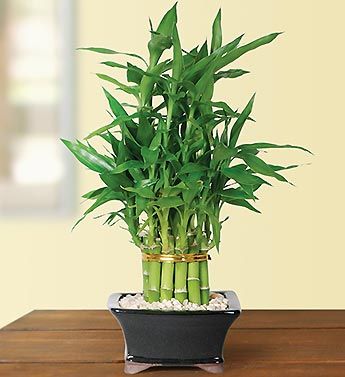
Dracaena sanderiana. Copyright: BonsaiDirect
This article is for Lucky Bamboo grown in water; click here to learn more about the true indoor Bamboo.
Contents
- Top Tips
- Location, Water, Humidity & Fertilisation
- Common Issues
- Origins, Temperature, Propagation, Repotting & Toxicity.
Need the answer to a specific plant query? Book a 1-to-1 video call with THE HOUSEPLANT DOCTOR™, the website's friendly author, to overcome and address your niggling problem! Available on iMessage, WhatsApp, Facebook Messenger & more.
Top Tips & Info
- Care Difficulty - Easy
- Lucky Bamboo is best located in bright, indirect light away from the risk of sun-scorch. More than an hour of direct sun may result in bleached foliage, whereas deep shade will increase the likelihood of basal rot.
- Good water hygiene is essential for a successful specimen. Replace the water once every week with lukewarm tap water, adding a few drops of 'Houseplant' labelled fertiliser every forth water change.
- You can place your Bamboo in compost whenever you'd like, using a 'Houseplant' labelled potting mix and an appropriate-sized pot. Follow the care tips mentioned in the article linked above.
- Those kept in water will grow much slower than others in soil. It's difficult to bend the juvenile growth into a curvature for aesthetics, so allow the plant to grow naturally throughout its life. Never convert a soil-borne specimen into water by removing the soil from its roots, as you'll cause 'Transplant Shock' that'll eventually kill it outright.
Location & Light - 🔸🔸
Like most houseplants, bright indirect light is best for quality growth. Although a shadier location is acceptable, prepare for slowed growth and exaggerated phototropism. Never allow the Bamboo to endure all-day sun as it'll lead to sun-scorch, resulting in a 'washed-out' appearance. If it were up to us, we'd recommend situating it in a location that offers indirect light in the autumn and winter, while increasing the light to include one or two hours of morning sunlight in the autumn and winter.
Water Hygiene - 🔸🔸🔸
Clean conditions are critical for happy Bamboo. If you fail to replace the water on a weekly basis, you'll run the risk of root rot and yellowed foliage. When irrigating, use tepid water to prevent hurting their sensitive roots from the sudden temperature change - if it's too cold for your teeth, it'll be the same with the plant, too! Although rainwater is best, if you decide to use tap water, allow it to stand for 24hrs to settle the levels of both chloride and fluoride. Large quantities of these chemicals will gradually build up in the soil over the oncoming months, damaging both its overall health and the soil quality.
Humidity - 🔸
Average room humidity is excellent for Lucky Bamboo, as over-misting may cause the development of powdery mildew or botrytis in areas of poor air circulation. At monthly intervals, perform a gentle hose-down to hydrate its leaves and reduce the number of dust particles resting on its foliage.
Fertilisation - 🔸
Add five drops of a 'Houseplant' labelled concentrate fertiliser every forth water change, all year round (as mentioned in 'Water Hygiene'). Don't go overboard with fertilisation as excessive root burn may spell the end of sensitive specimens.
Common Issues with Lucky Bamboo
Yellow lower leaves with a blackened or yellowed stem (closest to soil) are a clear sign of poor water sanitation, usually accompanied by too little light - scroll down to the image below for visual reference. Although Lucky Bamboo can do well in darker locations, the frequency of irrigations must be reduced to counteract the chance of root rot. People don't realise that a plant's root system needs access to oxygen too, so when the water stays stagnant for a long period of time, the oxygen will travel upwards and leave the fluid. A lack of accessible oxygen for the roots will cause them to subsequently breakdown over the oncoming days. If the stem's base or roots begins to wither and rot, which is accompanied with yellowing leaves, prune off the main stem so that you're left with the lateral branch on its own. Discard the main stem as the bacteria would have travelled into the new growth to render the specimen useless. As a last resort, place the lateral stem into fresh water to redevelop a healthy root system. Once there is around 3cm (1 1/2 inches) of root growth, place the plant's bottom third in a 7cm pot with a 'Houseplant' labelled potting mix.
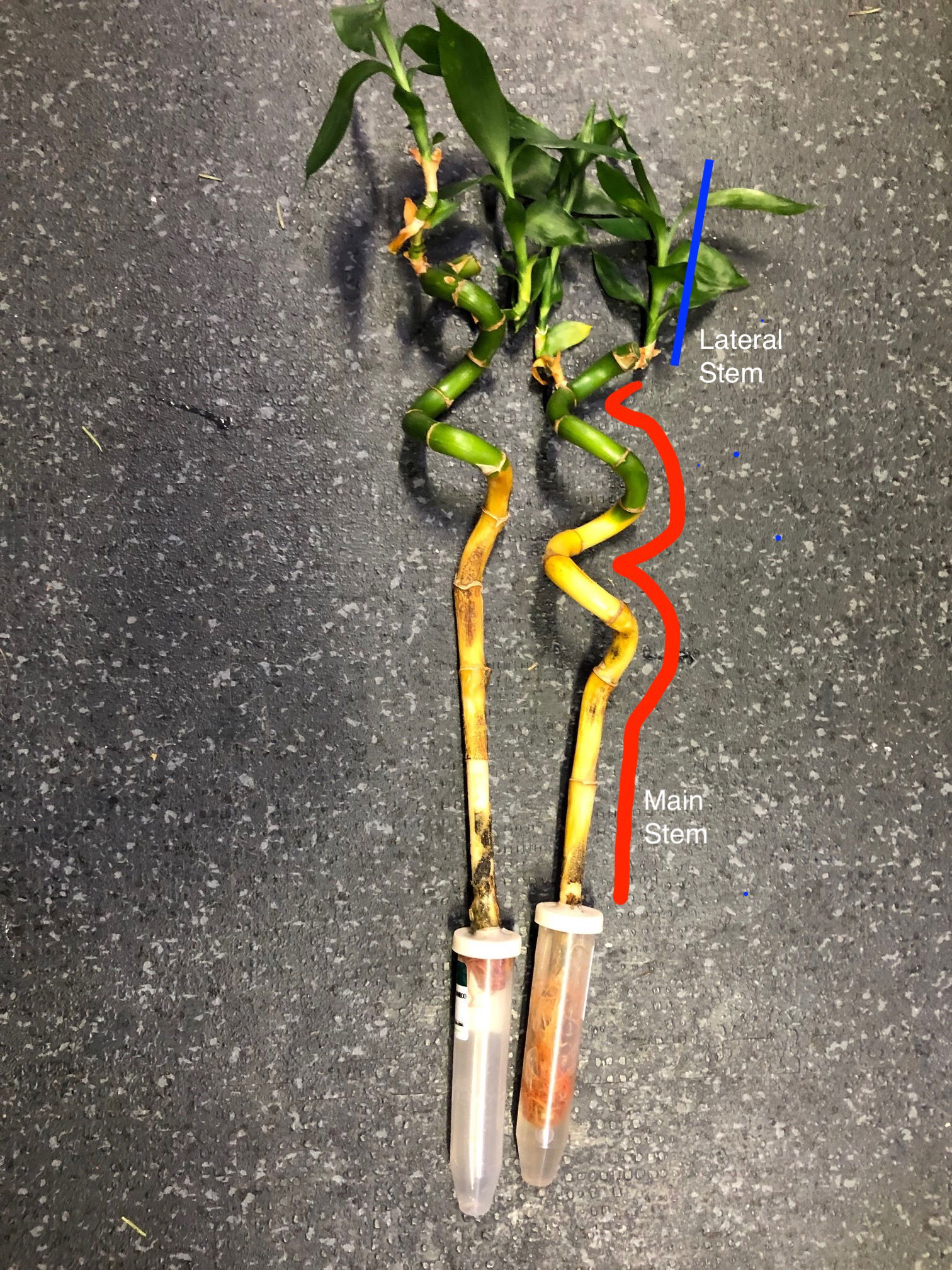 The coloured lines represent the two sections on the plant, mentioned in this article - the lateral stem and main stem. The photo also includes the symptoms for poor water sanitation where the water wasn't changed frequently.
The coloured lines represent the two sections on the plant, mentioned in this article - the lateral stem and main stem. The photo also includes the symptoms for poor water sanitation where the water wasn't changed frequently.
Spider Mites are small, near-transparent critters, that'll slowly extract the chlorophyll from of its leaves. Have a check under the leaves, most notably along the midrib, for small webs and gritty yellow bumps. Click here to read our article about the eradicating Spider Mites, along with some extra tips that you may not find elsewhere!
Yellowing leaf-tips are the product of cold water or too much fluoride in the soil. This issue is caused by using tap water which hasn't sat for 24hrs to alleviate the chemicals via evaporation. We'd recommend switching it for collected rainwater or fresh bottled water to improve its health, along with the reduction of its fluoride-count. The older leaves will always bear the scars of the past, but the new foliage should be as good as new within the next six weeks.
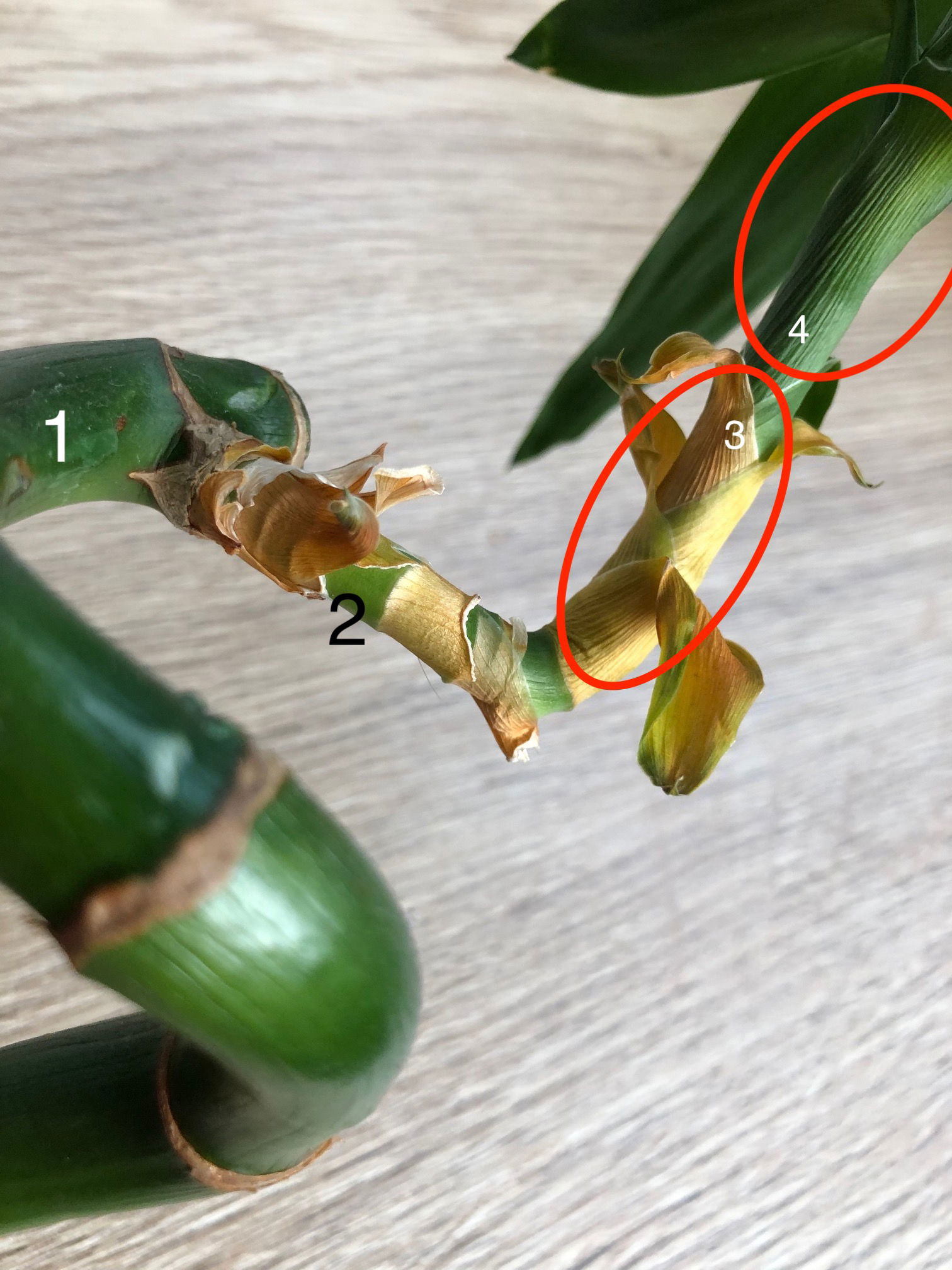 Another example of the main stem (1) and its lateral stem (2). Although yellow older leaves are part and parcel of maturity (3), if this is accompanied by a shrivelled stem (4), the specimen may have been under-watered. Read the following paragraph to learn more about this issue.
Another example of the main stem (1) and its lateral stem (2). Although yellow older leaves are part and parcel of maturity (3), if this is accompanied by a shrivelled stem (4), the specimen may have been under-watered. Read the following paragraph to learn more about this issue.
In some cases, a yellow shrivelled stem could be the product of dehydration. If this has happened to yours, sit your plant in more water to see whether it can still competently absorb moisture. Take stem cuttings off its lateral growth if the plant continues to decline; follow the tips provided in the first paragraph of 'Common Issues'.
Origins
Lucky Bamboo isn't part of the Bamboo family and instead forms part of the genus, Dracaena. The name derives from the Greek for a female dragon 'Drakaina', referring to the red sap and green foliage. The species' name, 'D. sanderiana', was first penned by Maxwell Masters in 1892, honouring German Orchidologist, Henry Frederick Conrad Sander.
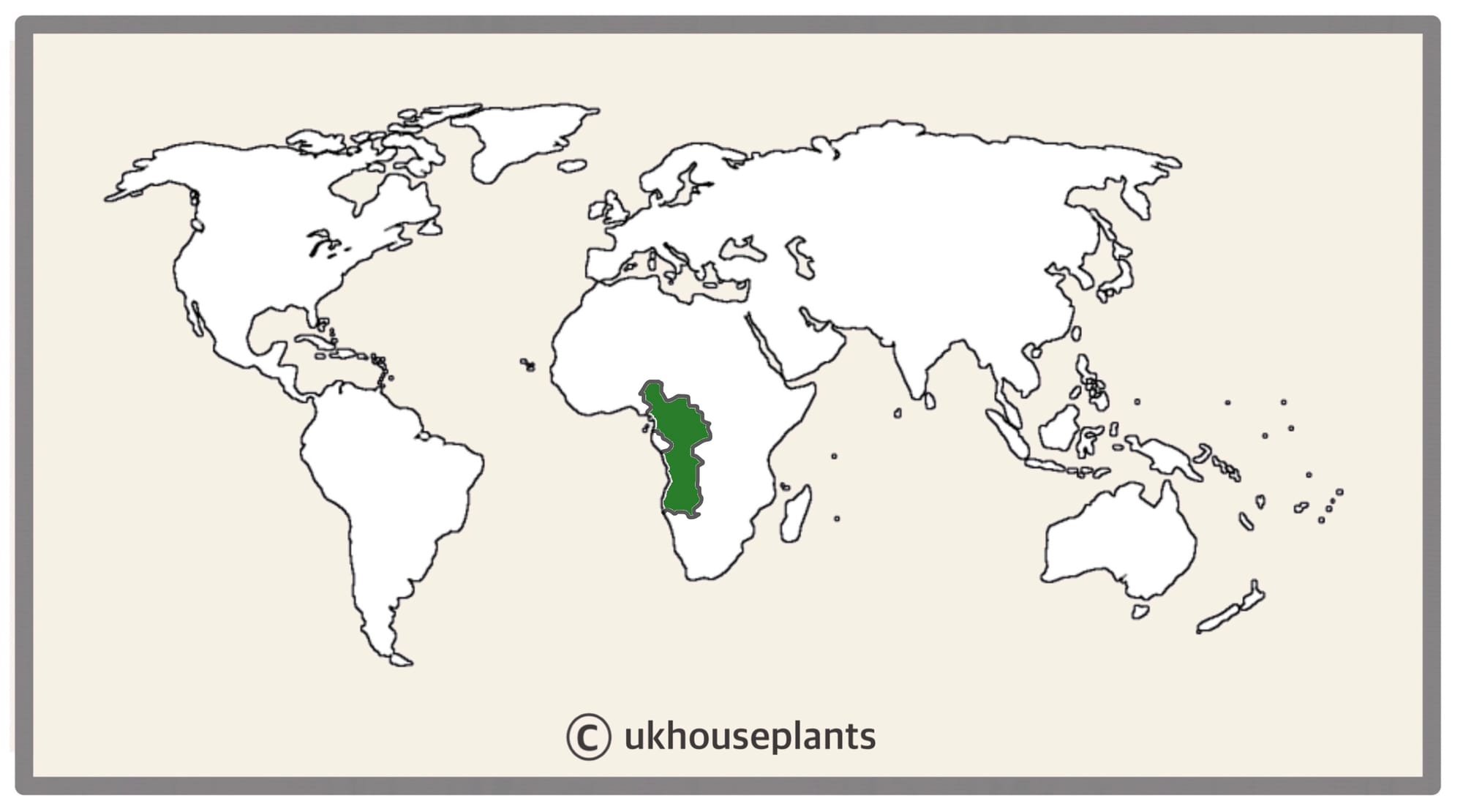 The Distribution of Dracaena sanderiana.
The Distribution of Dracaena sanderiana.
Temperature
12° - 32°C (54° - 90°F
H1b (Hardiness Zone 12) - Can be grown outdoors during the summer in a sheltered location with temperatures above 12℃ (54℉), but is fine to remain indoors, too. If you decide to bring this plant outdoors, don't allow it to endure any direct sunlight as it may result in sun-scorch and dehydration. Regularly keep an eye out for pests, especially when re-introducing it back indoors.
Spread
Over 1.5m in height and 0.6m in width when grown in soil; whilst situated in water, the specimen's growth rates will slow dramatically.
Pruning & Maintenance
Remove yellow or dying leaves, and plant debris to encourage better-growing conditions. While pruning, always use clean scissors or shears to reduce the chance of bacterial and fungal diseases. Never cut through yellowed tissue as this may cause further damage in the likes of diseases or bacterial infections. Remember to make clean incisions as too-damaged wounds may shock the plant, causing weakened growth and a decline in health.
When the plant becomes leggy, you can also prune the lateral branches in the spring to promote a bushier appearance. We don't recommend pruning its roots due to the risk of damaging the overall health of the specimen.
Propagation
Via Seed & Stem Cuttings.
Stem Cuttings (Easy)
- Hygiene is the most crucial element of successful propagation. The secateurs must be dirt-free with a fresh (or well stored) batch of compost. As you'll be cutting through vulnerable tissue, using uncleanly equipment will introduce harmful pathogens to the cutting and its mother plant.
- For stem cuttings, the best specimens are those located at the lateral growths and not the thicker stem. You should aim for a semi-wooded base that's pencil-thick and still juvenile to slightly bend. Never use diseased or weakened growth, as this will likely fail to root. Make the best incision possible to prevent the development of disease and remove the bottom half of the leaves.
- Decide on rooting the cutting via water or soil. The first option tends to have better success, especially if you're a new-time propagator. For the prior method, remove any rotten debris and replace the water every week with lukewarm tap water to prevent shocking the plant. Although collected rainwater is acceptable, the risk of harboured diseases is too high, especially with an open wound. Once the roots surpass 3cm, you can safely pot it up.
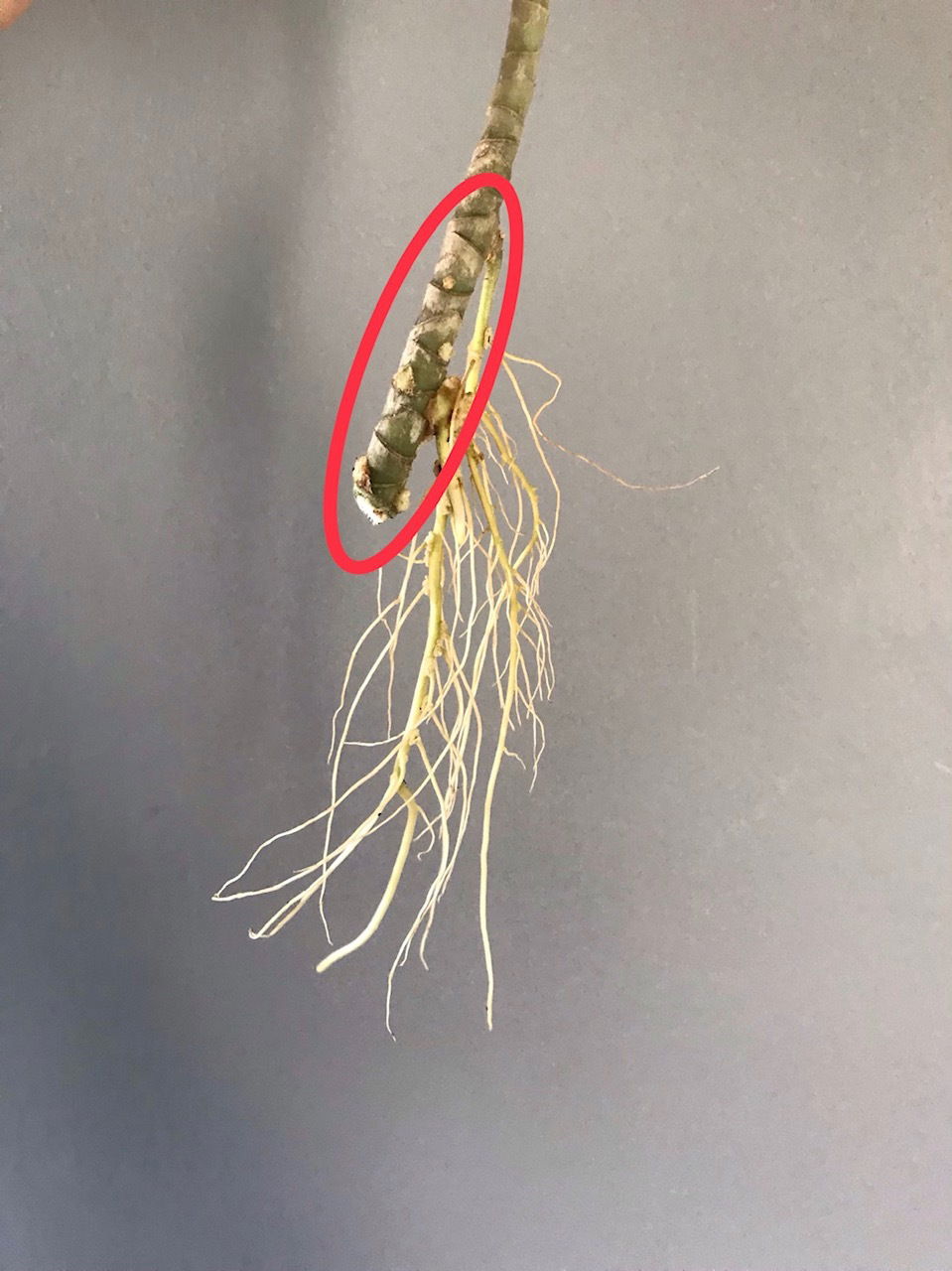 After several weeks in water, areas will begin to callous (small white bumps), thus starting the rooting process.
After several weeks in water, areas will begin to callous (small white bumps), thus starting the rooting process. - For both options, (water & soil) use an aerated soil that has a fluffy texture with some perlite, too. Never use a poorly stored bag of compost as it'll promote larvae or perennial seeds to arise. We would recommend using 'Houseplant compost' as it has a great balance between being water-retentive, but still 'airy' enough to promote root growth. Use a 7cm pot that has adequate drainage holes.
- Place a 2cm layer of soil at the bottom of the pot, and then rest the cutting vertically in the middle. You may have the cutting for support.
- Fill the soil around its base, making sure that its bottom half is submerged and NOT the leaves.
- Never press or compact the soil; condensing it to support the cutting will push the oxygen above the soil line, suffocating the roots until they rot. If it needs support, introduce a cane or something that won't condense the soil when inserted!
- Place the potted cutting in a transparent bag or box. Because of the lack of roots, it'll start to lose stored water very quickly. A confided environment will lock-in the humidity and reduce the rate of respiration and transpiration considerably.
- You'll rarely have to water the soil due to the high humidity. If the soil compacts itself after the first irrigation, level it out by adding more compost.
- Open the bag every few days for fresh air. Be sure to keep the soil evenly moist, but NOT soggy - if it looks saturated, leaves it. The surrounding humidity in the container will do its job by hydrating the leaves.
- Situate in a bright, indirect location away from any heat sources (i.e. radiators). Keep the temperature around 18℃ (64℉) as this is the optimum temperature for root development - you can even use a bottom-heat pad to speed-up the process. The roots will develop BEFORE the foliage, so bear that in mind if you're an impatient gardener. Safely remove the bag or box once new leaves emerge, as, at this point, there'll be a sufficient root system. Introduce a Pebble Tray to maintain a good level of atmospheric saturation and to reduce the severity of environmental shock
- Keep the soil moist and maintain a bright, indirect location away from direct sunlight and other heat sources. After around four months, transplant into a slightly bigger pot, keeping in mind transplant shock (where the root hairs are damaged or over-touched) and follow the care-tips provided above.
Flowers
Small, globular white or pink flowers are arranged along a thick flower shaft that'll appear horizontally towards the top half of the stem, lasting several weeks. It's highly unlikely that a domestically grown specimen will bloom indoors due to the unfavored growing conditions of too low humidity and consistent temperature levels throughout the year.
Repotting
Converting a water-borne specimen into soil is easy, fun and wholly safe. Not only will the specimen's growth rates quicken in the coming months, but its overall health will also improve dramatically. For those originally in water, place the plant's bottom third in a 7cm pot with adequate drainage to promote good, healthy roots.
For already-rooted specimens, transplant every three years in the spring using a 'Houseplant' labelled compost and the next sized pot with adequate drainage. Hydrate the plant 24hrs before tinkering with the roots to prevent the risk of 'Transplant Shock'. Add a thin layer of small grit in the pot's base and the lower portion of the new compost to improve drainage & downplay over-watering. Click here for a detailed step-by-step guide on transplantation, or via this link to learn about repotting with root rot.
Book a 1-to-1 video call with THE HOUSEPLANT DOCTOR™ if you'd like a personal guide to repotting your houseplant. This will include recommending the right branded-compost and pot size, followed by a live video call whilst you transplant the specimen for step-by-step guidance and answer any further questions!
Pests & Diseases
Keep an eye out for mealybugs, spider mites, scale, thrips & whitefly that'll locate themselves in the cubbyholes and undersides of the leaves. Common diseases are root rot, leaf-spot disease, botrytis, powdery mildew & southern blight - click here to learn more about these issues.
Toxicity
This plant is classified as poisonous. If parts of the plants are eaten, vomiting, nausea and a loss of appetite could occur. Consumption of large quantities must be dealt with quickly - acquire medical assistance for further information.
Retail Locations
British Garden Centres, B&Q, Dobbies, Homebase, IKEA, Online Stores.
Book a 1-to-1 Call with THE HOUSEPLANT DOCTOR™
If you need further advice with your houseplants, book an advice call with ukhouseplants' friendly and expert writer today! This can be done via a video or audio call on most apps, including Facebook, FaceTime & Skype. A ten-minute call costs £5.99 (US$7), or £15.99 for thirty minutes. You can ask multiple questions, including queries on plants, pests, terrariums, repotting advice and anything in between. Please consider supporting this service to keep ukhouseplants thriving!